Normal approach and landing procedures are used when the engine power is available, the wind is light or the final approach is made directly into the wind, the final approach path has no obstacles, and the landing surface is firm and of ample length to gradually bring the airplane to a stop. The selected landing point is normally beyond the runway approach threshold but within the first 1⁄3 of the runway. The factors involved and the procedures described for the normal approach and landing also have applications to the other-than-normal approaches and landings discussed in this site. The principles of normal operations are explained first and need to be understood before proceeding to the more complex operations. To better understand the factors that influence judgment and procedures, the last part of the approach pattern and the actual landing are divided into five phases:
- the base leg
- the final approach
- the round out (flare)
- the touchdown
- the after-landing roll
Base Leg
The placement of the base leg is one of the important judgments made by the pilot to set up for a good landing. [Figure 1] The pilot accurately judges the height, distance from the approach end of the runway, and rate of descent to allow a stabilized approach, round out, and touchdown at the desired spot. The distance depends on the altitude of the base leg, the current winds, and the amount of wing flaps used. When there is a strong wind on final approach or the flaps are used to produce a steep angle of descent, the base leg should be positioned closer to the approach end of the runway than would be required with normal winds or flap settings. Normally, the landing gear is extended and the before-landing check completed prior to reaching the base leg.
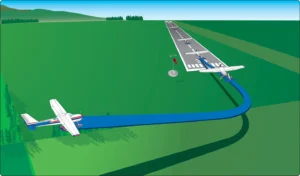
After turning onto the base leg, the pilot starts or continues the descent with reduced power and a target airspeed of approximately 1.4 VSO—the stalling speed in the landing configuration. For example, if VSO is 60 knots, 1.4 VSO is 84 knots (84 = 1.4 x 60). Landing flaps should be deployed as recommended. Full flaps are not recommended until the final approach is established. Since the final approach and landing are normally made into the wind, there is usually a crosswind during the base leg. A drift correction is established and maintained to follow a ground track perpendicular to the extension of the landing runway centerline. This requires that the airplane be angled sufficiently into the wind to prevent drifting farther away from the intended landing spot.
Final Approach
After the base-to-final approach turn is completed, the pilot aligns the longitudinal axis of the airplane with the centerline of the runway or landing surface. On a final approach, with no crosswind, the longitudinal axis is kept aligned with the runway centerline throughout the final approach and landing. (Methods to correct for a crosswind are explained in the “Crosswind Approach and Landing post. For now, only approaches and landings where the wind is straight down the runway are discussed.)
After aligning the airplane with the runway centerline, the final flap setting is completed and the pitch attitude adjusted as required. Some adjustment of pitch and power may be necessary to maintain the desired rate of descent and approach airspeed. The pilot should use the manufacturer’s recommended airspeed or 1.3 VSO if there is no manufacturer’s recommendation. As the pitch attitude and airspeed stabilize, the airplane is re-trimmed to relieve any control pressure.
The descent angle is controlled throughout the approach so that the airplane lands in the center of the first third of the runway. The descent angle is affected by all four fundamental forces that act on an airplane (lift, drag, thrust, and weight). If all the forces are balanced out such that the net force on the airplane is zero, the descent angle remains constant in a steady state wind condition. The pilot controls these forces by adjusting the airspeed, attitude, power, and drag (flaps or forward slip). However, wind may affect the gliding distance over the ground [Figure 2]; the pilot does not have control over the wind, but corrects for its effect on the airplane’s descent by adjusting pitch and power appropriately.
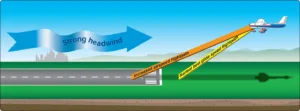
A well-executed final approach includes reaching the desired touchdown point at an airspeed that results in minimum floating just before touchdown. To accomplish this, both the descent angle and the airspeed need to be controlled. This is one reason for performing approaches with partial power; if the approach is too high, the pilot can lower the nose and reduce the power to maintain the correct airspeed. When the approach is too low, the pilot can add power and raise the nose.
While the proper angle of descent and airspeed are maintained by integrating pitch and power changes, an untrained or inexperienced pilot may try to reach a landing spot by applying back-elevator pressure without adding power. However, attempting to stretch the final approach by raising the pitch attitude alone is almost always a bad idea. Using pitch alone causes a significant increase in AOA and decay in airspeed that leads to an excessive rate of descent or a low altitude stall. It is possible for either or both to occur.
Wrong Surface Landing Avoidance
A wrong surface landing occurs when an aircraft lands or tries to land on the wrong runway, on a taxiway in error, or at the wrong airport. The pilot should take a moment on every final approach to verify the correctness of the landing zone ahead.
Lack of familiarity with a particular airport, complacency, or fatigue may lead to pilot confusion, and occasionally a pilot will line up with the wrong surface while perceiving the situation as normal. A pilot may compensate for any lack of destination airport familiarity by studying an airport diagram and lighting ahead of time and noting key features and geometry. On final approach, the pilot should verify correct runway alignment and runway number. Pilots often refer to moving map displays driven by GPS, and these devices should increase situational awareness and safety. If there is a doubt over the landing surface, the pilot should go around and consider the situation further.
Stabilized Approach Concept
A stabilized approach is one in which the pilot establishes and maintains a constant-angle glide path towards a predetermined point on the landing runway. It is based on the pilot’s judgment of certain visual clues and depends on maintaining a constant final descent airspeed and configuration.
An airplane descending on final approach at a constant rate and airspeed travels in a straight line towards a spot on the ground ahead, commonly called the aiming point. If the airplane maintains a constant glide path without a round out for landing, it will strike the ground at the aiming point. [Figure 3]
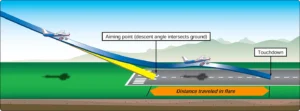
To the pilot, the aiming point appears to be stationary. It does not appear to move under the nose of the aircraft and does not appear to move forward away from the aircraft. This feature identifies the aiming point—it does not move. However, objects in front of and beyond the aiming point do appear to move as the distance is closed, and they appear to move in opposite directions! For a constant angle glide path, the distance between the horizon and the aiming point remains constant.
If descending at a constant angle and the distance between the perceived aiming point and the horizon appears to increase (aiming point moving down away from the horizon), then the true aiming point is farther down the runway. If the distance between the perceived aiming point and the horizon decreases, meaning that the aiming point is moving up toward the horizon, the true aiming point is closer than perceived.
During instruction in landings, one of the important skills a pilot acquires is how to use visual cues to discern the true aiming point from any distance out on final approach. From this, the pilot determines if the current glide path will result in either an under or overshoot. Note that the aiming point is not where the airplane actually touches down. Since the pilot reduces the rate of descent during the round out (flare), the actual touchdown occurs farther down the runway. Considering float during round out, the pilot is also able to predict the point of touchdown with some accuracy.
When the airplane is established on final approach, the shape of the runway image also presents clues as to what should be done to maintain a stabilized approach to a safe landing.
Obviously, a runway is normally shaped in the form of an elongated rectangle. When viewed from the air during the approach, the phenomenon, known as perspective, causes the runway to assume the shape of a trapezoid with the far end looking narrower than the approach end and the edge lines converging ahead.
As an airplane continues down the glide path at a constant angle (stabilized), the image the pilot sees is still trapezoidal, but of proportionately larger dimensions. In other words, during a stabilized approach, the runway shape does not change. [Figure 4]

If the approach becomes shallow, the runway appears to shorten and become wider. Conversely, if the approach is steepened, the runway appears to become longer and narrower. [Figure 5]

Immediately after rolling out on final approach, the pilot adjusts the pitch attitude, power, and trim so that the airplane is descending directly toward the aiming point at the appropriate airspeed in the landing configuration. If it appears that the airplane is going to overshoot the desired landing spot, a steeper approach results by reducing power and lowering the pitch attitude to maintain airspeed. If available and not fully extended, the pilot may further extend the flaps. If the desired landing spot is being undershot and a shallower approach is needed, the pilot increases both power and pitch attitude to reduce the descent angle.
Once the approach is set up and control pressures removed with trim, the pilot is free to devote significant attention toward outside references and use the available visual cues to fine tune the approach. The pilot should not stare at any one place, but rather scan from one point to another, such as from the aiming point to the horizon, to any objects along the runway, to an area well short of the runway, and back to the aiming point. This makes it easier to perceive any deviation from the desired glide path and determine if the airplane is proceeding directly toward the aiming point. The pilot should also glance at the airspeed indicator periodically and correct for any airspeed deviation.
Pilots normally establish a stabilized approach before short final. The round out, touchdown, and landing roll are much easier to accomplish when preceded by a stabilized final approach, which reduces the chance of a landing mishap. Therefore, deviations from the desired glide path should be detected and corrected early so that the magnitude of corrections during the later portion of the approach is small. If the approach is very high or very low, it may not be possible to establish a stabilized approach, and the pilot normally executes a go-around.
If the airplane is initially low and undershooting the aiming point, the pilot may intercept the desired glide path by increasing pitch attitude and adding power to level off while maintaining the correct airspeed. This may necessitate a substantial increase in power if the aircraft is operating on the backside of the power curve. As the airplane intercepts the desired glide path, the pilot reduces power and pitches down to remain on the glide path. Retracting the flaps to correct for an undershoot creates an unnecessary risk. It may cause a sudden decrease in lift, an excessive sink rate, and an aggravated unstable condition.
If the approach is too high or too low, it may not be possible to establish a stabilized approach, and the pilot should execute a go-around. Typically, pilots go-around if unable to establish a stabilized approach by 500 ft above airport elevation in visual meteorological conditions (VMC) or 1,000 ft above airport elevation in instrument conditions (IMC). For a typical GA piston aircraft in a traffic pattern, an immediate go-around should be initiated if the approach becomes unstabilized below 300 ft AGL.
Pilots may consider the following elements when attempting to set up and fly a stabilized approach to landing. The pilot should focus on the elements that lead to a stabilized approach rather than the order of the elements or the insistence on meeting all of the approach criteria. For a typical piston aircraft, an approach is stabilized when the following criteria are met:
- Glide path. Typically a constant 3 degrees to the touchdown zone on the runway (obstructions permitting).
- Heading. The aircraft tracks the centerline to the runway with only minor heading/pitch changes necessary to correct for wind or turbulence to maintain alignment. Bank angle normally limited to 15 degrees once established on final.
- Airspeed. The aircraft speed is within +10 /-5 KIAS of the recommended landing speed specified in the AFM, 1.3VSO, or on approved placards/markings. If the pilot applies a gust factor, indicated airspeed should not decay below the recommended landing speed.
- Configuration. The aircraft is in the correct landing configuration with flaps as required; landing gear extended, and is in trim.
- Descent rate. A descent rate (generally 500-1000 fpm for light general aviation aircraft) makes for a safe approach. Minimal adjustments to the descent rate as the airplane approaches the runway provide an additional indication of a stabilized and safe approach. If using a descent rate in excess of 500 fpm due to approach considerations, the pilot should reduce the descent rate prior to 300 ft AGL.
- Power setting. The pilot should use a power setting appropriate for the aircraft configuration and not below the minimum power for approach as defined by the AFM.
- Briefings and checklists. Completing all briefings and checklists prior to initiating the approach (except the landing checklist), ensures the pilot can focus on the elements listed above.
Estimating Airplane Movement and Height
During short final, round out, and touchdown, vision is of prime importance. To provide a wide scope of vision and to foster good judgment of height and movement, the pilot’s head should assume a natural, straight-ahead position. Visual focus is not fixed on any one side or any one spot ahead of the airplane. Instead, it is changed slowly from a point just over the airplane’s nose to the desired touchdown zone and back again. This is done while maintaining a deliberate awareness of distance from either side of the runway using peripheral vision.
Accurate estimation of distance, besides being a matter of practice, depends upon how clearly objects are seen. It requires that vision be focused properly so that the important objects stand out as clearly as possible.
Speed blurs objects at close range. For example, most everyone has noted this in an automobile moving at high speed. Nearby objects seem to merge together in a blur, while objects farther away stand out clearly. The driver subconsciously focuses the eyes sufficiently far ahead of the automobile to see objects distinctly.
The distance at which the pilot’s vision is focused should be proportional to the speed at which the airplane is traveling over the ground. Thus, as speed is reduced during the round out, the distance ahead of the airplane at which it is possible to focus is brought closer accordingly.
If the pilot attempts to focus on a reference that is too close or looks directly down, the reference becomes blurred, [Figure 6] and the reaction is either too abrupt or too late. In this case, the pilot’s tendency is to over-control, round out high, and make full-stall, drop-in landings. If the pilot focuses too far ahead, accuracy in judging the closeness of the ground is lost and the consequent reaction is too slow, since there does not appear to be a necessity for action. This sometimes results in the airplane flying into the ground nose first. The change of visual focus from a long distance to a short distance requires a definite time interval, and even though the time is brief, the airplane’s speed during this interval is such that the airplane travels an appreciable distance, both forward and downward toward the ground.
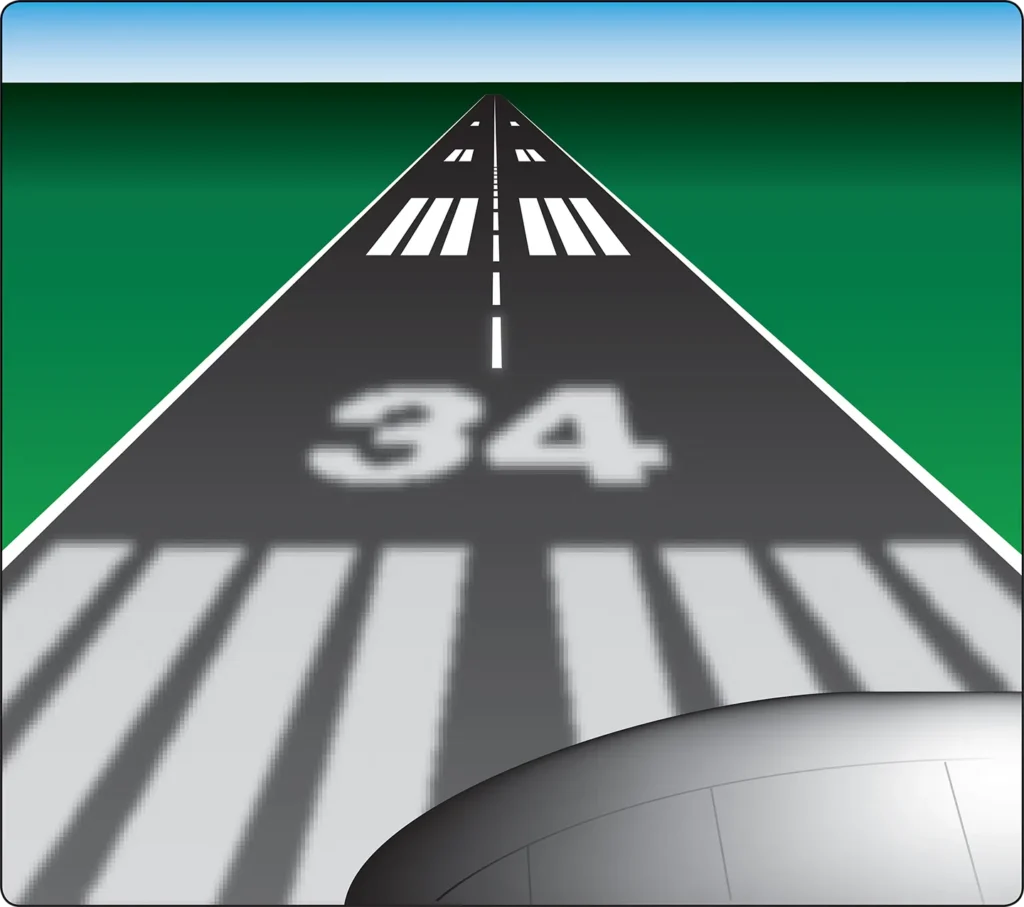
Visual cues are important in flaring at the proper height and maintaining the wheels a few inches above the runway until eventual touchdown. Flare cues are primarily dependent on the angle at which the pilot’s central vision intersects the ground (or runway) ahead and slightly to the side. Proper depth perception is a factor in a successful flare, but the visual cues used most are those related to changes in runway or terrain perspective and to changes in the size and texture of familiar objects near the landing area. The pilot should focus direct central vision at a shallow downward angle from 10° to 15° relative to the runway as the round out/flare is initiated. [Figure 7]
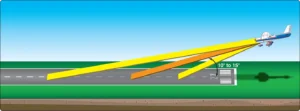
When using this steady viewing angle, the point of visual interception with the runway appears progressively closer as the airplane loses altitude. This rate of closure is an important visual cue in assessing the rate of altitude loss. Conversely, movement of the visual interception point further down the runway indicates an increase in altitude and means that the pitch angle was increased too rapidly during the flare. Location of the visual interception point in conjunction with assessment of flow velocity of nearby off-runway terrain, as well as the similarity of appearance of height above the runway ahead of the airplane (in comparison to the way it looked when the airplane was taxied prior to takeoff), is also used to judge when the wheels are just a few inches above the runway.
Round Out (Flare)
The round out is a slow, smooth transition from a normal approach attitude to a landing attitude, gradually rounding out the flightpath to one that is parallel to and a few inches above the runway. When the airplane approaches 10 to 20 feet above the ground in a normal descent, the round out or flare is started. Back-elevator pressure is gradually applied to slowly increase the pitch attitude and AOA. [Figure 8] The AOA is increased at a rate that allows the airplane to continue settling slowly as forward speed decreases. This is a continuous process until the airplane touches down on the ground.
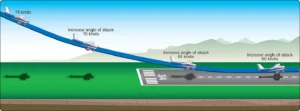
When the AOA is increased, the lift is momentarily increased and this decreases the rate of descent. Since power normally is reduced to idle during the round out, the airspeed also gradually decreases. This causes lift to decrease again and necessitates raising the nose and further increasing the AOA. During the round out, the airspeed is decreased to touchdown speed while the lift is controlled so the airplane settles gently onto the landing surface. The round out is executed at a rate such that the proper landing attitude and the proper touchdown airspeed are attained simultaneously just as the wheels contact the landing surface.
The rate at which the round out is executed depends on the airplane’s height above the ground, the rate of descent, and the pitch attitude. A round out started excessively high needs to be executed more slowly than one started from a lower height. The round out rate should also be proportional to the rate of closure with the ground. When the airplane appears to be descending very slowly, the increase in pitch attitude should be made at a correspondingly slow rate.
The pitch attitude of the airplane in a full-flap approach is considerably lower than in a no-flap approach. To attain the proper landing attitude before touching down, the nose needs to travel through a greater pitch change when flaps are fully extended. Since the round out is usually started at approximately the same height above the ground regardless of the degree of flaps used, the pitch attitude should be increased at a faster rate when full flaps are used. However, the round out should still be executed at a rate that takes the airplane’s downward motion into account.
Once the actual process of rounding out is started, the pilot should not push the elevator control forward. If too much back-elevator pressure was exerted, this pressure is either slightly relaxed or held constant, depending on the degree of the error. In some cases, it may be necessary to advance the throttle slightly to prevent an excessive rate of sink or a stall, either of which results in a hard, drop-in type landing.
It is recommended that a pilot form the habit of keeping one hand on the throttle throughout the approach and landing should a sudden and unexpected hazardous situation require an immediate application of power.
Touchdown
The touchdown is the gentle settling of the airplane onto the landing surface. The round out and touchdown are normally made with the engine idling. During the round out, the airspeed decays such that the airplane touches down on the main gear at or just above the approximate stalling speed. As the airplane settles, proper landing attitude is attained by application of whatever back-elevator pressure is necessary.
Some pilots try to force or fly the airplane onto the ground without establishing proper landing attitude. The airplane should never be flown onto the runway with excessive speed. A common technique to making a smooth touchdown is to actually focus on holding the wheels of the aircraft a few inches off the ground as long as possible using the elevators while the power is smoothly reduced to idle.
In most cases, when the wheels are within 2 or 3 feet of the ground, the airplane is still settling too fast for a gentle touchdown. Therefore, this descent is retarded by increasing back-elevator pressure. Since the airplane is already close to its stalling speed and is settling, this added back-elevator pressure only slows the settling instead of stopping it. At the same time, it results in the airplane touching the ground in the proper landing attitude and the main wheels touching down first so that little or no weight is on the nose-wheel. [Figure 9]

After the main wheels make initial contact with the ground, back-elevator pressure is held to maintain a positive AOA for aerodynamic braking and to hold the nose-wheel off the ground as the airplane decelerates. The pilot should be certain not to inadvertently have brake pressure engaged as touchdown occurs. Early use of brakes can result in a sudden drop in the nose and a loss of aerodynamic braking. As the airplane’s momentum decreases, back-elevator pressure is gradually relaxed to allow the nose-wheel to gently settle onto the runway. This permits steering if the airplane has a steerable nose-wheel. At the same time, it decreases the AOA and reduces lift on the wings to prevent floating or skipping and allows the full weight of the airplane to rest on the wheels for better mechanical braking action. As the airplane slows, the mechanical braking becomes more effective.
It is extremely important that the touchdown occur with the airplane’s longitudinal axis exactly parallel to the direction in which the airplane is moving along the runway. Failure to accomplish this imposes severe side loads on the landing gear. To avoid these side stresses, the pilot should not allow the airplane to touch down while turned into the wind or drifting.
After-Landing Roll
The landing process should never be considered complete until the airplane decelerates to the normal taxi speed during the landing roll or has been brought to a complete stop when clear of the landing area. Accidents may occur as a result of pilots abandoning their vigilance and failing to maintain positive control after getting the airplane on the ground.
A pilot should be alert for directional control difficulties immediately upon and after touchdown due to the ground friction on the wheels. Loss of directional control may lead to an aggravated, uncontrolled, tight turn on the ground, or a ground loop. The combination of centrifugal force acting on the center of gravity (CG) and ground friction of the main wheels resisting it during the ground loop may cause the airplane to tip or lean enough for the outside wingtip to contact the ground. This imposes a sideward force that could collapse the landing gear.
The rudder serves the same purpose on the ground as it does in the air—it controls the yawing of the airplane. The effectiveness of the rudder is dependent on the airflow, which depends on the speed of the airplane. As the speed decreases and the nose-wheel has been lowered to the ground, the steerable nose provides more positive directional control.
The brakes of an airplane serve the same primary purpose as the brakes of an automobile—to reduce speed on the ground. In airplanes, they are also used as an aid in directional control when more positive control is required than could be obtained with rudder or nose-wheel steering alone.
To use brakes, on an airplane equipped with toe brakes, the pilot slides the toes or feet up from the rudder pedals to the brake pedals. If rudder pressure is being held at the time braking action is needed, the pilot should not release that pressure as the feet or toes are being slid up to the brake pedals because control may be lost before brakes can be applied.
Putting maximum weight on the wheels after touchdown is an important factor in obtaining optimum braking performance. During the early part of rollout, some lift continues to be generated by the wing. After touchdown, the nose-wheel is lowered to the runway to maintain directional control. During deceleration, applying brakes may cause the nose to pitch down and some weight to transfer to the nose-wheel from the main wheels. This does not aid in braking action, so back pressure is applied to the controls without lifting the nose-wheel off the runway. This enables directional control while keeping weight on the main wheels.
Careful application of the brakes is initiated after the nose-wheel is on the ground and directional control is established. Maximum brake effectiveness is just short of the point where skidding occurs. If the brakes are applied so hard that skidding takes place, braking becomes ineffective. Skidding is stopped by releasing the brake pressure. Braking effectiveness is not enhanced by alternately applying, releasing, and reapplying brake pressure. The brakes are applied firmly and smoothly as necessary.
During the ground roll, the airplane’s direction of movement can be changed by carefully applying pressure on one brake or uneven pressures on each brake in the desired direction. Caution must be exercised when applying brakes to avoid over-controlling.
The ailerons serve the same purpose on the ground as they do in the air—they change the lift and drag components of the wings. During the after-landing roll, they are used to keep the wings level in much the same way they are used in flight. If a wing starts to rise, aileron control is applied toward that wing to lower it. The amount required depends on speed because as the forward speed of the airplane decreases, the ailerons become less effective. Procedures for using ailerons in crosswind conditions are explained in the “Crosswind Approach and Landing” post.
Once the airplane has slowed sufficiently and has turned onto the taxiway and stopped, the pilot performs the after-landing checklist. Many accidents have occurred as a result of the pilot unintentionally operating the landing gear control and retracting the gear instead of the flap control when the airplane was still rolling. The habit of positively identifying both of these controls, before actuating them, should be formed from the very beginning of flight training and continued in all future flying activities. If available runway permits, the speed of the airplane is allowed to dissipate in a normal manner.
Common Errors
Common errors in the performance of normal approaches and landings are:
- Failure to complete the landing checklist in a timely manner.
- Inadequate wind drift correction on the base leg.
- An overshooting, undershooting, too steep, or too shallow a turn onto final approach.
- A skidding turn from base leg to final approach as a result of overshooting/inadequate wind drift correction.
- Poor coordination during turn from base to final approach.
- Unstable approach.
- Failure to adequately compensate for flap extension.
- Poor trim technique on final approach.
- Attempting to maintain altitude or reach the runway using elevator alone.
- Focusing too close to the airplane resulting in a too high round out.
- Focusing too far from the airplane resulting in a too low round out.
- Touching down prior to attaining proper landing attitude.
- Failure to hold sufficient back-elevator pressure after touchdown.
- Excessive braking after touchdown.
- Loss of aircraft control during touchdown and rollout.
